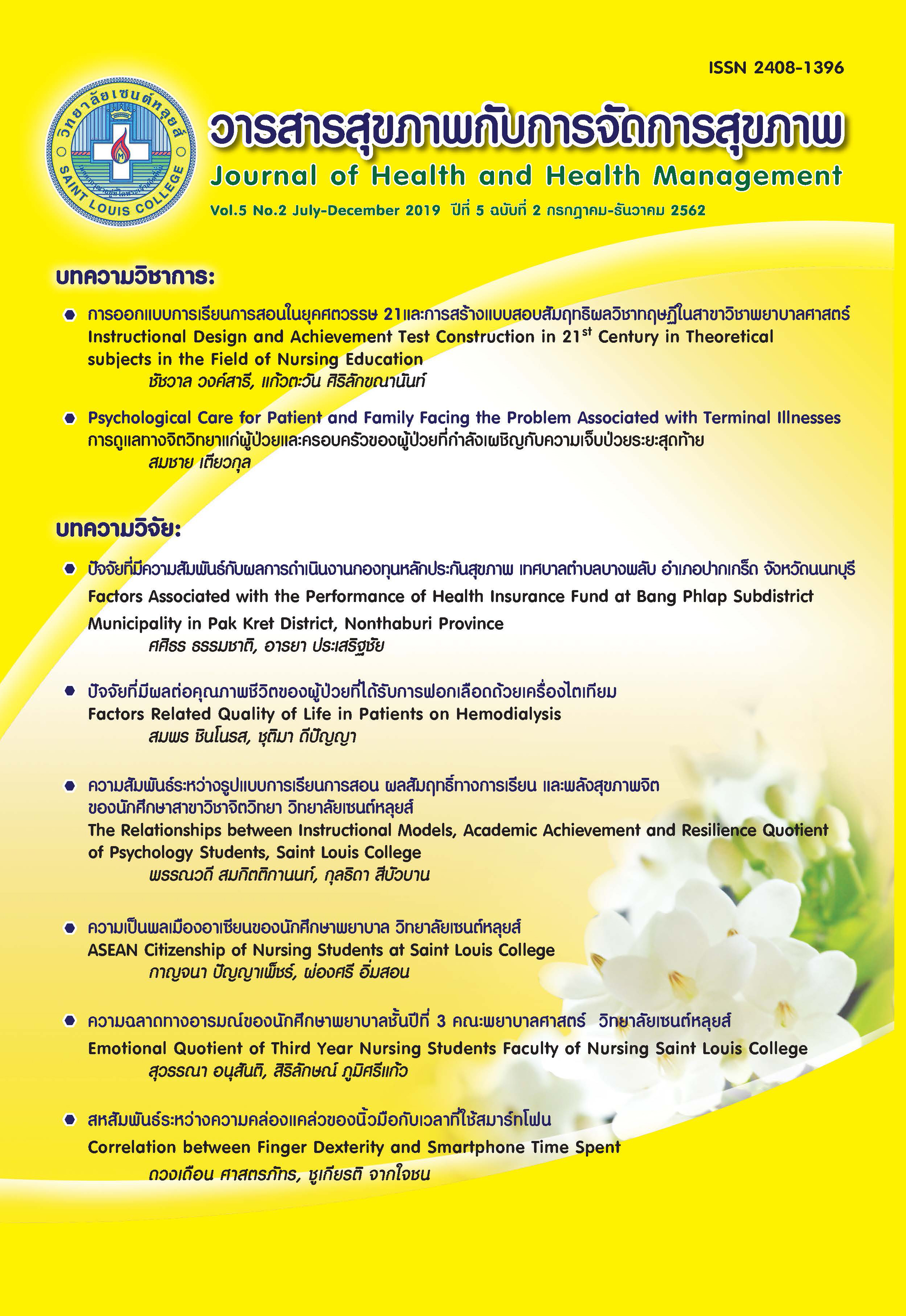การออกแบบการเรียนการสอนในยุคศตวรรษ 21 และการสร้างแบบสอบสัมฤทธิผล วิชาทฤษฏีในสาขาวิชาพยาบาลศาสตร์
คำสำคัญ:
การออกแบบการสอนในยุคศตวรรษ 21, การสร้างแบบสอบสัมฤทธิผล, การศึกษาพยาบาลศาสตร์บทคัดย่อ
ปัจจุบันประเทศไทยมีจำนวนสถาบันการศึกษาพยาบาลเพิ่มขึ้น จึงมีพยาบาลจากสายปฏิบัติเปลี่ยนมาทำงานในสายวิชาการมากขึ้น แต่เนื่องจากจัดการเรียนการสอนในสาขาวิชาพยาบาลศาสตร์ผู้สอนจำเป็นต้องมีความรู้ทางด้านศึกษาศาสตร์ด้วย เพราะเชื่อว่าการออกแบบการเรียนการสอนที่มีประสิทธิภาพเท่านั้น จึงจะช่วยพัฒนาผู้เรียนไปสู่ผลลัพธ์ของการเรียนรู้อย่างมีประสิทธิผล และที่สำคัญในกระบวนการจัดการเรียนการสอนนอกจากผู้สอนต้องคงไว้ซึ่งมาตรฐานของหลักวิชาแล้ว ยังต้องปรับเปลี่ยนกระบวนการสอนให้สอดคล้องตามลักษณะของผู้เรียนด้วย ดังนั้นเพื่อให้การจัดการเรียนการสอนในสาขาวิชาพยาบาลศาสตร์ดำเนินไปด้วยประสิทธิภาพและประสิทธิผลผู้เขียนจึงเขียนบทความนี้ขึ้นโดยมุ่งอธิบายวิธีการออกแบบการจัดการเรียนการสอน การวางแผนสร้างแบบสอบทางการศึกษาพยาบาลศาสตร์ในวิชาทฤษฎี ให้คณาจารย์ในสาขาวิชาพยาบาลศาสตร์ได้เข้าใจและนำไปประยุกต์สู่การเขียนวัตถุประสงค์การเรียนรู้และ กำหนดคำที่ใช้วัดให้สอดคล้องกับวัตถุประสงค์เชิงพฤติกรรมได้ถูกต้อง ซึ่งมีความสำคัญและสัมพันธ์กับการวางแผนการสอน นอกจากนี้ยังเสนอวิธีการสอนให้สอดคล้องกับผู้เรียนพยาบาลในยุคศตวรรษที่ 21 หรือนักศึกษาพยาบาลเจเนอเรชั่นแซด และสาระของการสร้างแบบสอบวัดสัมฤทธิ์ผลตามมาตรฐานวิชาชีพ โดยมีตัวอย่างการวิเคราะห์พิมพ์เขียวการออกข้อสอบให้ผู้อ่านได้เกิดความเข้าใจมากยิ่งขึ้น
เอกสารอ้างอิง
ชัชวาล วงค์สารี. (2557). ผลของโปรแกรมการให้ความรู้แบบเข้มข้นต่อความรู้เรื่องการจำกัดน้ำในผู้ป่วยโรคไตวายเรื้อรังระยะสุดท้ายที่ฟอกเลือดด้วยเครื่องไตเทียม.(วิทยานิพนธ์พยาบาลศาสตร มหาบัณฑิตสาขาการพยาบาลผู้ใหญ่) กรุงเทพฯ: มหาวิทยาลัยหัวเฉียวเฉลิมพระเกียรติ.
ชัชวาล วงค์สารี. (2558). การสอนบนคลินิกในรายวิชาการปฏิบัติการพยาบาลผู้ใหญ่และผู้สูงอายุสำหรับนักศึกษา Generation Z. วารสารวิทยาลัยพยาบาลบรมราชชนนีกรุงเทพ, 31( 2), 130 - 140.
ชัชวาล วงค์สารี. (2559). แนวคิดร่วมสมัยในการจัดการเรียนการสอนสาขาพยาบาลศาสตร์. สไลด์ประกอบการบรรยายแก่ครูพี่เลี้ยงประจำแหล่งฝึกปฏิบัติ คณะพยาบาลศาสตร์ มหาวิทยาลัยคริสเตียน. สืบค้นวันที่ 10 มกราคม 2561, จาก https://www.teacher.ssru.ac.th/chutchavarn_wo/.
ชัชวาล วงค์สารี. (2559a). คำนิยามวิธีการสอน วัตถุประสงค์และการวัดประเมินผลที่สอดคล้องกับวิธีการสอนรูปแบบต่างๆ. กาญจนบุรี: คณะพยาบาลศาสตร์ มหาวิทยาลัยเวสเทิร์น. (อัดสำเนา).
ชัชวาล วงค์สารี. (2560). คู่มือ การวิเคราะห์ข้อสอบทางการพยาบาลและการผดุงครรภ์. (พิมพ์ครั้งที่ 2). กรุงเทพฯ: ห้างหุ้นส่วนจำกัด เอ็น พี เพรส.
ชัชวาล วงค์สารี. (2561). การจัดการเรียนรู้แบบผู้ใหญ่ : การเรียนรู้และเข้าใจผู้เรียนยุค Generation Z, สไลด์ประกอบการบรรยายแก่คณาจารย์และครูพี่เลี้ยง ณ วิทยาลัยพยาบาลบรมราชชนนีสุราษฏร์ธานี. สืบค้นเมื่อวันที่ 27 กรกฎาคม 2561, จาก https://www.teacher.ssru.ac.th/chutchavarn_wo/.
ชัชวาล วงค์สารี และอุทัยวรรณ พงษ์บริบูรณ์. (2557). กฎหมายและจรรยาบรรณวิชาชีพการพยาบาลและกฎหมายอื่นที่เกี่ยวข้อง. กรุงเทพฯ : ห้างหุ้นส่วนจำกัด เอ็น พี เพรส.
เชิดศักดิ์ ไอรมณีรัตน์, สุพจน์ พงศ์ประสบชัย, รุ่งนิรันดร์ ประดิษฐสุวรรณ. (2556). แนวคิดของการสอนทางคลินิก. คณะแพทยศาสตร์ศิริราชพยาบาลมหาวิทยาลัยมหิดล: กรุงเทพเวชสาร.
เยาวดี รางชัยกุล วิบูลย์ศรี. (2552). การวัดผลและสร้างแบบสอบวัดผลสัมฤทธิ์. (พิมพ์ครั้งที่ 8). กรุงเทพฯ: จุฬาลงกรณ์มหาวิทยาลัย.
สมชาย รัตนทองคำ. (2554). การออกแบบการสอนที่เป็นระบบ : เอกสารประกอบการสอนทางกายภาพบำบัด. คณะเทคนิคการแพทย์ มหาวิทยาลัยขอนแก่น. (อัดสำเนา).
เอกรินทร์ สี่มหาศาล, สมเกียรติ ภู่ระหงษ์, บุญลักษณ์ เอี่ยมสำอางค์, และปิยากร เพชรรัตน์. (2553). นวัตกรรมการเรียนการสอน. (ฉบับปรับปรุงครั้งที่ 2). กรุงเทพฯ: เทคนิคพริ้นติ้ง.
Anderson, L. W., Krathwohl, D. R., Airasian, P. W., Cruikshank, K. A., Mayer, R. E., Pintrich, P. R., . . . Wittrock, M. C. (2001). A taxonomy for learning, teaching, and assessing: A revision of Bloom’s taxonomy of educational objectives, abridged edition. White Plains, NY: Longman.
Bloom, B. S. (1956). Taxonomy of educational objectives: The classification of educational goals: Cognitive Domain: Longman.
Bloom, B. S. (1985). Generalizations about talent development. Developing talent in young people, 507-549.
Cant, R. P., & Cooper, S. J. (2011). The benefits of debriefing as formative feedback in nurse education. Australian Journal of Advanced Nursing, 29(1), 37.
Demirtas, H., & Hedeker, D. (2016). Computing the point-biserial correlation under any underlying continuous distribution. Communications in Statistics-Simulation and Computation, 45(8), 2744-2751.
Dyess, S. M., & Sherman, R. O. (2009). The first year of practice: New graduate nurses’ transition and learning needs. The Journal of Continuing Education in Nursing, 40(9), 403-410.
Krathwohl, D. R. (2002). A revision of Bloom’s taxonomy: An overview. Theory into practice, 41(4), 212-218.
Kizlik, B.(2011). How to write learning objectives that meet demanding behavioral criteria. Recuperado de https://www.adprima.com/objectives.htm.
Nicol, D. (2007). E-assessment by design: using multiple-choice tests to good effect. Journal of Further and higher Education, 31(1), 53-64.
Schmehl, P. (2014). Introduction to concept mapping in nursing. Jones & Bartlett Publishers.
Sladek, S. & Grabinger, A. (2014). Gen Z The first generation of the 21st century has arrived! XYZUniversity. Retrieved July 27, 2018 form https://xyzuniversity.com/wp-content/uploads/2014/02/GenZ_Final.pdf.
Snow, E. L., Jackson, G. T., & McNamara, D. S. (2014). Emergent behaviors in computer - based learning environments : Computational signals of catching up. Computers in Human Behavior. (41), 62-70.




